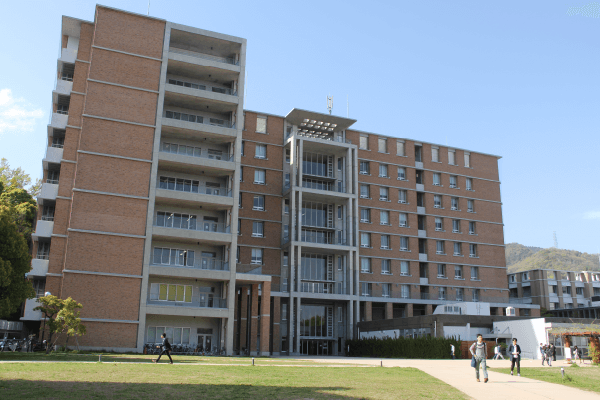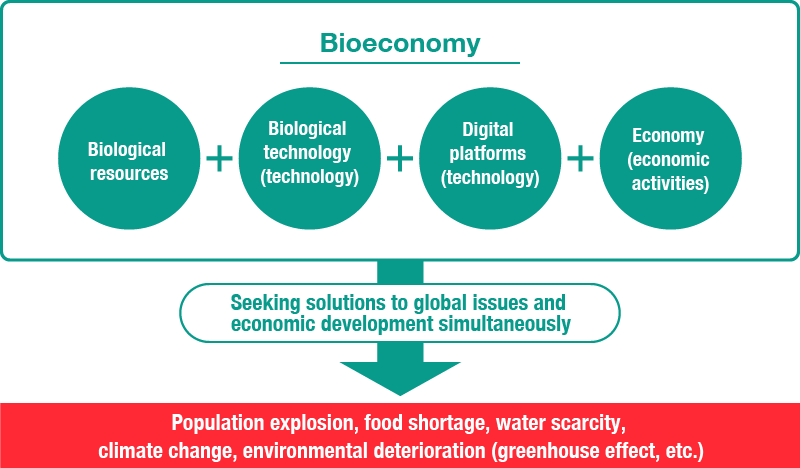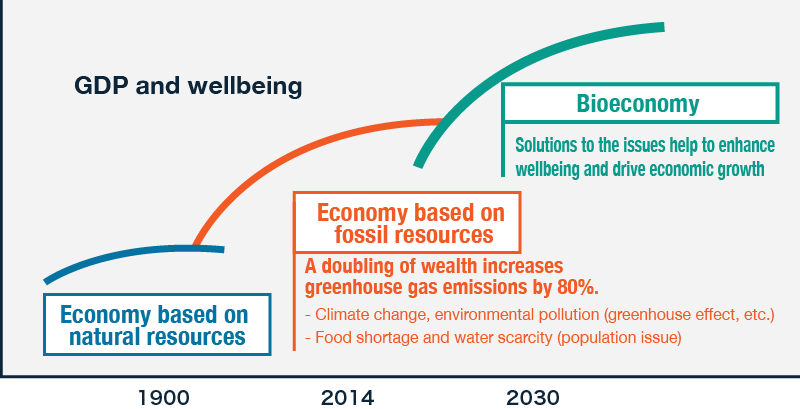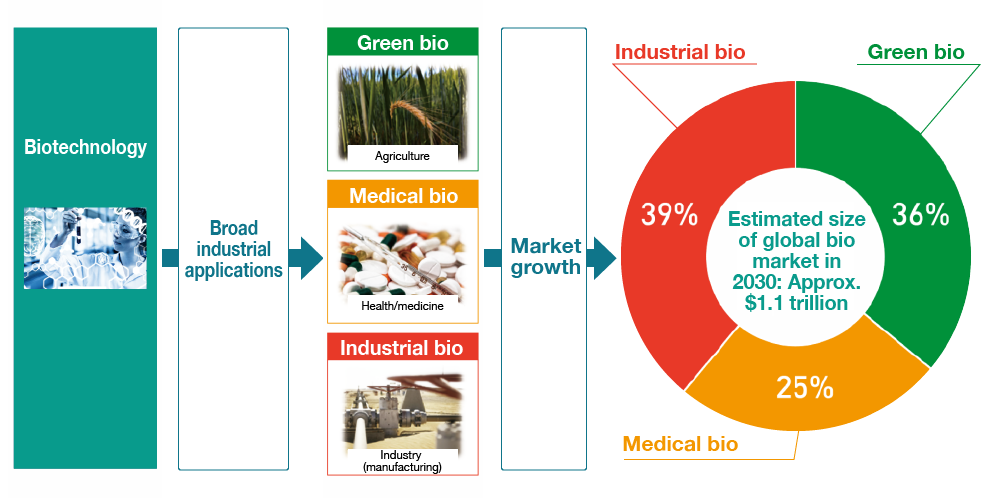Bioeconomy Research Unit
Overview

Contributing to the Realization of the Bioeconomy Through Investigation and Research on innovation
The concept of “bioeconomy” is gaining traction. Up until the end of the 17th century, the primary energy source for industry was wood, which was replaced by coal by the mid-18th century, and steam engines triggered the first industrial revolution. As oil subsequently took the place of coal, the second industrial revolution was observed between the end of the 19th century and the early 20th century, when technological breakthroughs were achieved in heavy industries (steel, machinery, and shipbuilding) and chemical industries (fertilizers, synthetic fibers, and pharmaceuticals). Then, progress in electronics toward the end of the 20th century brought on the third industrial revolution. Today, we are said to be in the middle of the fourth industrial revolution, a time during which the Internet of Things (“IoT”), artificial intelligence (AI), and big data are reshaping industrial structures.
One of the drawbacks of economic growth is the deterioration of the global environment due to the mass consumption of fossil resources. A serious challenge in modern society is finding a way to achieve economic growth in a sustainable manner, and it has recently become more of a real possibility that biological resources will be the solution to this challenge. Attempts are being made to reduce total consumption of fossil resources by using renewable biological resources not only as energy sources in place of fossil resources but also as materials for industrial products. The idea of balancing economic growth with measures to protect the global environment through the integrated use of biological resources, biotechnology, and digital platforms encompasses a wide variety of research and development projects, industrial policies, economic activities, all designed to achieve a “bioeconomy”.
The Organization for Economic Cooperation and Development (OECD) estimates that the bio market could grow to contribute up to 2.7% of GDP (approximately 150 trillion yen) by 2030, about 40% of which would be accounted for by industrial bio business that uses biological resources for manufacturing. Behind this balancing act are striking technological innovations in the field of synthetic biology, such as genome editing and DNA synthesis, and those in the field of digital technology, such as the advent of a next-generation sequencer, which has dramatically increased the efficiency of genomic analysis, and rapid progress in AI and automation. In other words, the fusion of biotechnology and digital technology, both of which have made rapid progress in recent years, is ushering in what could be called the fifth industrial revolution, as it has elucidated the phenomenon of life and made it possible to apply biological functions to industrial applications.
Nevertheless, it takes more than the combination of these cutting-edge technologies to make bioeconomy a reality. What is essential here are entrepreneurs who will lead technological breakthroughs to innovations that will create both economic and social value and a strategy conceived from economic and management points of view. This research unit aims to contribute to the creation of bioeconomy through research and investigation focused on the creation of innovation in the engineering biology field.
The Bioeconomic Wave
In recent years, the approach of seeking solutions to global issues and driving economic development simultaneously through the strategic use of the latest technology and biological resources has come to the forefront.

Seeking solutions to global issues and economic growth simultaneously
“Bioeconomy will be the next wave of economy”
- Finnish Government (2014) -

Source: Vision for Social Contributions by the Growing Bioindustries, Japan Association of Bioindustries Executives
The Advent of the Age of the Bioeconomy
The global bio market is expected to grow to approximately 150 trillion yen (amongst OECD member countries) in a wide range of fields, including agriculture, health/medicine, and industry.

Source: The Bioeconomy to 2030, OECD, 2009
The Rise of Synthetic Biology and Fusion of Information Technologies
The focus of biotechnology is shifting from “knowing, observing, and analyzing” living organisms to “designing and utilizing” them.
- The Human Genome Project started in 1990 with the aim of sequencing the entire human genome, and it was completed in 2003, the fiftieth anniversary of the discovery of the structure of DNA. This made it possible to gain the genome information of any living organism with ease. (Theoretically speaking, all kinds of biosynthesis pathways can be artificially reconstructed.)
This made it possible to gain the genome information of any living organism with ease. (Theoretically speaking, all kinds of biosynthesis pathways can be artificially reconstructed.) - Recent years have seen rapid progress in the fusion of AI and automation, the IoT (which integrates them), digital platforms that encompass cloud computing and other technologies, and synthetic biology technologies (i.e., biotechnology), such as genome editing and DNA synthesis.

Technological breakthroughs have made available large quantities of useful substances, which are stably produced from biological resources, such as microorganisms, plants, animal and plant cells, and algae.

Contributing to wide-ranging fields such as agriculture, health/medicine, and industry (manufacturing)
The Advent of the Age of “Digital x Bio”
Latest developments in the U.S.: Rise of biotech startups in the synthetic biology field
DNA synthesis
- Established in 2013 by Dr. Emily Leproust (now CEO), a renowned DNA researcher.
- Twist Bioscience has developed technology that achieves DNA synthesis with higher efficiency with a shorter delivery schedule and at a lower cost. This proprietary technology enables DNA synthesis that meets the specific needs of each customer.
- Twist Bioscience increased the efficiency of the DNA synthesis process by using original silicon plates, rather than conventional plastic plates. Their service is expected to be applied to a broad range of fields, including new drug discovery, new material production, agriculture, scientific research, medical diagnosis, and DNA storage.
- Listed on NASDAQ in 2018
All-in-one contract

- Ginkgo BioworksTM was founded in 2008 by Dr. Tom Night, one of the developers of the ARPANET, which paved the way for the Internet, as well as LISP workstations. He later came to be called the “godfather of synthetic biology,” and five other biology researchers (mostly in their 30s at the time) from the Massachusetts Institute of Technology (MIT).
- Through the combination of digital technology and highly automated processes, this biotech startups offers all-in-one solutions, improving strains and developing additives and artificial enzymes at the request of customers.
Shareholders’ equity: $565M
References
- Innovation Strategies of Biotech Startup Originating from Kobe University Ⅱ
A Paper on Innovation Strategies of Deep Science Venture Companies, Taking Synplogen Co., Ltd. a Kobe University-Launched Biotech startup, as a Case Study
Authors: Kazuhiko Yamamoto and Kiyokazu Iwata
http://www.egbrc.kobe-u.ac.jp/data/bio-venture.pdf - The 8th meeting of the Bio-Industry Subcommittee, Commerce, Distribution and Information Committee, Industrial Structure Council, Ministry of Economy, Trade and Industry website, December 2017
Appendix 3, “Creating the ‘Smart-cell’ Industry,” - Council for Science, Technology and Innovation (a meeting between the three political-level appointees including the minister in charge of science and technology policies and Diet members well-versed in related issues, concurrently members of the Council, FY2017), Cabinet Office website, October 2017
Appendix 2, “Strategy for Creating a New Economic Society (Bioeconomy) by Biotechnology x Digital Technology (Bioeconomy Strategy),” Commerce and Service Industry Policy Group, Ministry of Economy, Trade and Industry

